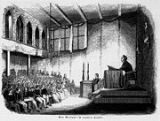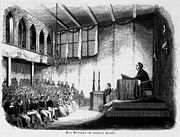
Rauhes Haus
Encyclopedia

Hamburg
-History:The first historic name for the city was, according to Claudius Ptolemy's reports, Treva.But the city takes its modern name, Hamburg, from the first permanent building on the site, a castle whose construction was ordered by the Emperor Charlemagne in AD 808...
, Germany
Germany
Germany , officially the Federal Republic of Germany , is a federal parliamentary republic in Europe. The country consists of 16 states while the capital and largest city is Berlin. Germany covers an area of 357,021 km2 and has a largely temperate seasonal climate...
. It shelters and trains children, the mentally handicapped and disturbed, and cares for the aged. It also trains people for social service careers.
History
Rauhes Haus was founded by the 25-year-old theologian Johann Hinrich WichernJohann Hinrich Wichern
Johann Hinrich Wichern was a founder of the Home Mission movement in Germany.-Biography:...
on 12 September 1833 who for a long time was head administrator at the institution. The name of the institution is a corruption of Ruges Haus as the institution started in an old house called by its former occupant “Ruges Hus,” which by a mistranslation into high German became “Rauhes Haus.”
It was connected with the German Home Mission (or Inner Mission
Inner mission
The Inner Mission was a movement of German evangelists, set up by Johann Hinrich Wichern in Wittenberg in 1848 based on a model of Theodor Fliedner...
), and started as an industrial institution for poor boys. The scope of the school widened with its growth, and in the early 20th century, besides forming a refuge for neglected children, it received boarding pupils from the higher income families and served as a training school for those wishing to become teachers, superintendents or assistants in hospitals, reformatories, houses of correction and the like. It was supported by voluntary contributions, profits arising from the productive enterprises it carried on, and fees from the richer pupils.
By the early 20th century, there was an average of 100 poor and neglected children, about one-third girls, receiving instruction within its walls. They lived in “families” of from 12 to 15, each “family” being under the care of one of the adult members of the mission training school.
The educational department was in the hands of assistants, who also took part in the instruction of the institution, in order to prepare themselves for the work of the Home Mission in other localities. This indeed became one of the most important features of the work carried on by the Rauhes Haus, and its graduates were found in every field of charitable work in Germany. The whole staff of assistants, consisted of young men of 20 to 29 years of age who were formed into a kind of society (Brüderschaft).
After 1844, the institution carried on a printing and book-binding business. Its newsletter was called the Fliegende Blätter.
Today
Today, this basic mission continues with broader criteria for its clientele. The house is owned by the foundation Stiftung Das Rauhe Haus of the German Diakonisches WerkDiakonisches Werk
The Diakonisches Werk is a charitable organization of Protestant churches in Germany , Austria as well as numerous free churches. Its Roman Catholic equivalent is the Caritas....
, the charitable work organization of German Lutheran churches.

